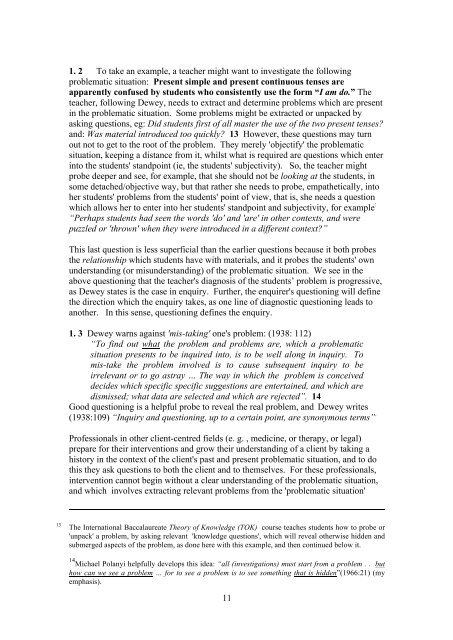RADICAL TEFL
2hqhXJd
2hqhXJd
Create successful ePaper yourself
Turn your PDF publications into a flip-book with our unique Google optimized e-Paper software.
1. 2 To take an example, a teacher might want to investigate the following<br />
problematic situation: Present simple and present continuous tenses are<br />
apparently confused by students who consistently use the form “I am do.” The<br />
teacher, following Dewey, needs to extract and determine problems which are present<br />
in the problematic situation. Some problems might be extracted or unpacked by<br />
asking questions, eg: Did students first of all master the use of the two present tenses?<br />
and: Was material introduced too quickly? 13 However, these questions may turn<br />
out not to get to the root of the problem. They merely 'objectify' the problematic<br />
situation, keeping a distance from it, whilst what is required are questions which enter<br />
into the students' standpoint (ie, the students' subjectivity). So, the teacher might<br />
probe deeper and see, for example, that she should not be looking at the students, in<br />
some detached/objective way, but that rather she needs to probe, empathetically, into<br />
her students' problems from the students' point of view, that is, she needs a question<br />
which allows her to enter into her students' standpoint and subjectivity, for example :<br />
“Perhaps students had seen the words 'do' and 'are' in other contexts, and were<br />
puzzled or 'thrown' when they were introduced in a different context?”<br />
This last question is less superficial than the earlier questions because it both probes<br />
the relationship which students have with materials, and it probes the students' own<br />
understanding (or misunderstanding) of the problematic situation. We see in the<br />
above questioning that the teacher's diagnosis of the students’ problem is progressive,<br />
as Dewey states is the case in enquiry. Further, the enquirer's questioning will define<br />
the direction which the enquiry takes, as one line of diagnostic questioning leads to<br />
another. In this sense, questioning defines the enquiry.<br />
1. 3 Dewey warns against 'mis-taking' one's problem: (1938: 112)<br />
“To find out what the problem and problems are, which a problematic<br />
situation presents to be inquired into, is to be well along in inquiry. To<br />
mis-take the problem involved is to cause subsequent inquiry to be<br />
irrelevant or to go astray … The way in which the problem is conceived<br />
decides which specific specific suggestions are entertained, and which are<br />
dismissed; what data are selected and which are rejected”. 14<br />
Good questioning is a helpful probe to reveal the real problem, and Dewey writes<br />
(1938:109) “Inquiry and questioning, up to a certain point, are synonymous terms” .<br />
Professionals in other client-centred fields (e. g. , medicine, or therapy, or legal)<br />
prepare for their interventions and grow their understanding of a client by taking a<br />
history in the context of the client's past and present problematic situation, and to do<br />
this they ask questions to both the client and to themselves. For these professionals,<br />
intervention cannot begin without a clear understanding of the problematic situation,<br />
and which involves extracting relevant problems from the 'problematic situation'<br />
13<br />
The International Baccalaureate Theory of Knowledge (TOK) course teaches students how to probe or<br />
'unpack' a problem, by asking relevant 'knowledge questions', which will reveal otherwise hidden and<br />
submerged aspects of the problem, as done here with this example, and then continued below it.<br />
14 Michael Polanyi helpfully develops this idea: “all (investigations) must start from a problem . . but<br />
how can we see a problem … for to see a problem is to see something that is hidden”(1966:21) (my<br />
emphasis).<br />
11


